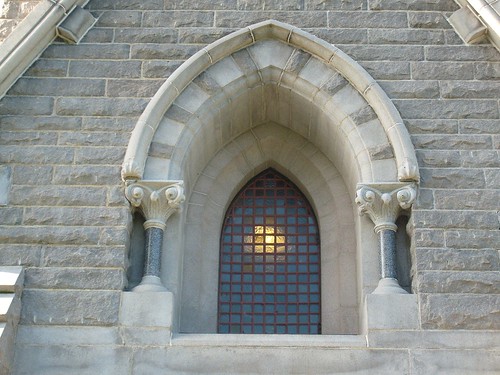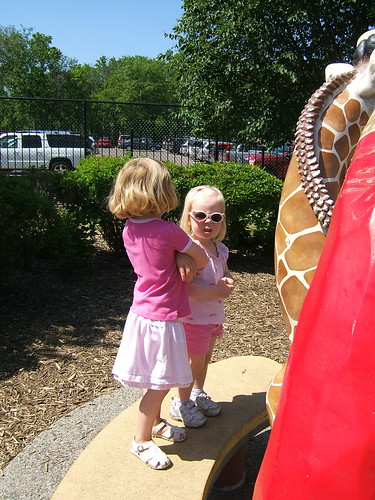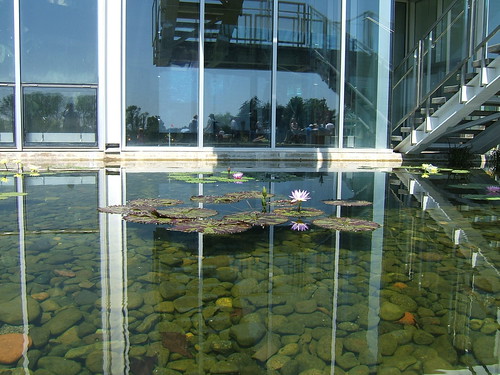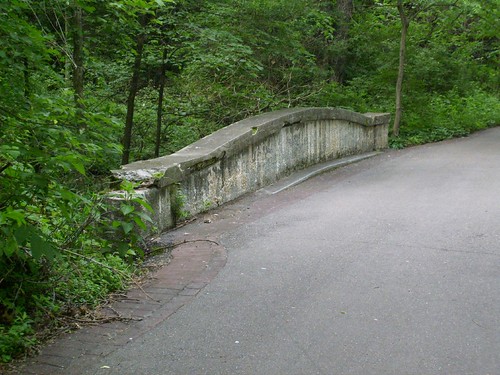Here is one of the modest homes on the main street between Skidmore College and downtown Saratoga Springs.
I skipped tonight’s conference-organized social activities (a chi-chi dinner and the New York City Ballet) in favor of a little drive down to the Saratoga battle site, which is just a few miles southeast of town. (My friend Rob recommended this outing, but I initially thought I wouldn’t have enough time. I was as wrong about that as Burgoyne was wrong about Clinton’s reinforcements in 1777.)
On the way out of town, I picked up a sandwich at a streetcorner deli in one of Saratoga Springs’ quiet residential neighborhoods. As I stood here, waiting for my cappicola hero, I realized that I had absentmindedly started watching the horserace feed on the TV. And that I was driving a car with New Jersey plates. Suddenly I was a character in the lamest Sopranos episode, the one about the grantwriter who orders a cappicola hero and watches a horserace on TV. Nothing else happens.
Soon enough, I was in Schuylerville, a little burg on the Hudson, due east of Saratoga Springs. There, I found the amazing Saratoga Monument, which commemorates the spot where British General John Burgoyne surrendered his army to the colonials in October 1777, ending Britain’s effort to split the rebellion into northern and southern halves.

The monument looks a lot like the Washington Monument, which was put up around the same time, and has four niches for statues of the heroes of the Battle of Saratoga: General Horatio Gates, General Philip Schuyler, Colonel Daniel Morgan, and General Benedict Arnold. Through Arnold was arguably the most important American commander at the battle, his niche is empty, owing to his treason in 1780.

Arnold’s niche faces south, toward the battlefield itself. Though I missed the cutoff time for the driving tour of the battlefield, I did spend a few minutes at the entrance to the park from the present-day highway. When Burgoyne came south from Canada to capture Albany, he tried to squeeze through this very gap between the Hudson on the east and the rougher, hilly terrain on the west – hills occupied by an American force that included artillery which commanded the river and the floodplain.
Burgoyne didn’t make it, being halted in September by American troops. He encamped here and waited weeks for reinforcements that he hoped had been sent up the river from New York by British Governor Sir Henry Clinton. Those troops never came, and Burgoyne’s men – mostly British troops, but also many Germans, some Indians, and quite a few women and children – ran out of supplies in the meantime. Finally, he ordered them to try to find the American lines and precipitate a battle that would allow him to move south again. But Burgoyne’s troops were now outnumbered by the Americans, who routed them on October 7. Retreating, Burgoyne led his men north, but bad weather and weakness slowed them, and they made it only as far as present-day Schuylerville, where American forces surrounded him and where he surrendered. The destruction of Britain’s main army in the north emboldened the Continental Army and induced Louis XVI to ally France with the American rebels, making the war into a global conflict and dramatically improving the military and political strength of the rebels.
Today was the full-on conference day, from the breakfast chit-chat at 7:30 a.m. through the cocktail hour and dinner, ending at 9 p.m. In between, we had four good sessions (and a lunch!). Throughout, I caught up with some colleagues I’ve met before – including a hilarious staffer from Barnard who is, and knows she is, basically a character in a Woody Allen movie. I also sampled some Saratoga Springs water, which was delicious and subtle, much lighter than San Pellegrino, and had a nice run through Skidmore’s “Northwoods” nature preserve. Now it’s time for bed.
Tomorrow we have fewer conference activities, so I think I might take advantage of our open time to head over to the Hudson River and see the historical monuments in Schuylerville, the town where, in 1777, British general John Burgoyne surrendered his army, breaking the king’s hold on the northern colonies and inducing the French to join the American colonies’ cause. Seems like a decent place to spend a few hours.
Owing to the vagaries of the airport shuttle from Northfield and the troubles inherent to contemporary air travel, I spent about twelve hours getting to Saratoga Springs, New York, today. It could have been much worse – I could have been one of the several people who had to open their airsickness bags on the bouncy, rocking descent to Albany.
Since I wasn’t, and thus can’t overshare by describing airborne stomach troubles, I’ll offer two trifles related to the flight:
1. Every time I see one of those electronic-gadget vending machines that are now ubiquitous on airport concourses, I wonder about the most expensive item inside. The machine near gate C10 at MSP topped out with the 32GB iPod Touch, on sale for $400.
2. Delta’s in-flight magazine included this gobsmacking item in their July events-around-the-world calendar:
Tours – Michael Jackson – The King of Pop created a frenzy when tickets went on sale for his “This Is It!” performances at London’s O2 Arena. the thrills commence July 8 and don’t beat it until February 24, 2010.
Or not.
Tomorrow morning I head off to a grants conference at Skidmore College in Saratoga Springs, New York. There is nothing like a business trip to rip open all kinds of psychological fissures. You’d need a dozen octopi for all the “one the one hand… on the other hand…” situations. The crowning aspect of any business trip, of course, is that it leaves one partner home alone with no shift change. This, Shannon does not like- not that she should. I don’t like that part of it much, either. As difficult as evenings can be (with Vivi’s hijinks), there’s no substitute for simply being there with the girls – which is what’s made it so unpleasant for me to be cut out of the bedtime routine these last few weeks and months.
On the other hand, I love traveling and especially seeing new places. Skidmore and Saratoga Springs both sound like fascinating places that’ll eat up my few hours of downtime. Having attended earlier iterations of this conference, I know it too will be great in all the important ways – such as finding new ways to drum up money for the college.
On the other other hand, travel like this is a pretty far cry from relaxing. The days are, after all, full of rather intense work. And yes, as Shannon reminds me, I can eat what and when I want and sleep without a baby monitor buzzing in my ear. But airplanes are not exactly dens of comfort and bliss, and having had quite a bit of the usual modern air-travel trouble every time I’ve flown for business, I doubt I’m going to arrive in Saratoga Springs tomorrow feeling particularly tanned, rested, or ready. But if all goes well, I will probably head home on Friday in a pretty good mood.
Our Fourth of July continued our tradition of busy Independence Days, including a long walk downtown to hang out with friends and watch the Northfield Criterium bike races, good naps, and a great party at some very generous friends’ spacious house in the countryside north of town. One girl is, at present, worn out; the other is wound up. This is a bad combination, but the day was fun enough that even the prospect of a rough bedtime can’t ruin the good moods.
(The picture above is the river side of the Froggy Bottoms restaurant/bar in downtown Northfield, done up for the holiday. It struck me that it looks a tiny bit like Monet’s Rue Montorgueil, Paris, Festival of June 30, 1878.)
I grant that today was the day before a three-day weekend, but the Carleton campus has been deader than the King of Pop all week. The only excitement anyone can find is a roofing project that requires a gargantuan red crane, apparently borrowed from Dubai, and periodic showers of roofing debris. If you visit the campus center after the snack bar closes (at 1:30 pm! well before my afternoon iced-coffee jones kicks in!), you’ll probably find only some dusty chairs, a groggy clerk in the bookstore, and the post office’s two bins of undeliverable magazines. (Anyone for fifty copies of the current Economist? Or twice as many copies of ESPN The Magazine?) In making – over the course of the week – four round-trip bike commutes and three walks to and from the Rec Center, I’ll bet I didn’t encounter a dozen people, total. Hell, in the Arb, I saw about three times as many red squirrels as people. And I saw three of those surly rodents.
Oh well. The plants in the little garden plot on the lawn between Olin, Goodsell, and Boliou have all sprouted now, as have signs all over campus inviting anyone – anyone? anyone! – to go ahead and pick whatever’s ripe. Anyone? Anyone! I don’t know about you, but I’m having radishes for lunch on Monday.
And the trees! God. The maples and oaks are shimmering with life. If you get too close, you might get knocked down by the photosynthesis. I discovered this beauty in the Upper Arb, just north of the concrete bridge near Bell Field – sublime, in the truest sense of beautiful, awe-inspiring, and a little bit frightening. This giant has already seen more summers than I ever will.
 The Ghost Map: The Story of London’s Most Terrifying Epidemic–and How It Changed Science, Cities, and the Modern World by Steven Johnson
The Ghost Map: The Story of London’s Most Terrifying Epidemic–and How It Changed Science, Cities, and the Modern World by Steven Johnson
rating: 5 of 5 stars
This book is hard to review in that it’s exactly what the jacket copy and other online reviews suggest: a cogent, informative, well-written narrative about London’s 1854 cholera epidemic, which was caused by the giant city’s pathetic sanitation system and ended when a brilliant scientist, John Snow, figured out that the disease was being transmitted through the (foul) water being consumed in one impoverished neighborhood. Along the way, Johnson describes the recycling economy of mid-nineteenth century London, the battles between those who thought disease was spread through the air and those who didn’t, the invisible importance of modern sanitation, the workings of bacterial diseases like cholera, and a host of other topics. I highly recommend the book.
I have only two cautions. First, much of the last chapter and all of the epilogue serve as an extended exercise in extrapolation – to modern megacities and to bioterrorism, chiefly – which would have been much more powerful at half the length. The book effectively ends midway through the last chapter, on the origins of the titular map, which is justifiably famous for visually summarizing the causes and effects of the outbreak.
Second, you should not read the book while eating. The details about London’s sanitation system and cholera are literally stomach-turning – though they also made me glad to live in a time and a place where my shit literally vanishes down the tubes and I can get clean, cold water at any time.
 Vision and Art: The Biology of Seeing by Margaret S. Livingstone
Vision and Art: The Biology of Seeing by Margaret S. Livingstone
rating: 5 of 5 stars
This is an excellent overview of the science and biology of seeing, especially as related to modern art. The author, Margaret Livingstone, a neurobiologist, skillfully presents the scientific material, though some of it is nonetheless pretty tough going. Livingstone, is very good at using a wide range of spectacular diagrams, photos, paintings, and other illustrations to advance her exposition and argument.
This argument – and its applicability to how we make and see art – rests on a critical distinction between our two overlapping systems of vision. Though colorblind, the older “Where” system of vision is good at detecting small changes in brightness (or what is technically called “luminance”), motion, spatial position or depth, and the general configuration of a scene. The evolutionary newer “What” system, present only in primates, is slightly slower and less sensitive to brightness but is capable of recognizing objects and their characteristics, including color and details. Livingstone’s discussion of the Where/What systems roams over topics ranging from the structure of the eye and the arrangement of visual ganglia to the functions of cones and rods and the critical “center/surround” neurons which are sensitive to sharp changes or breaks in luminance, rather than subtle shifts. She also comments more or less in passing on the evolutionary failings of the eye and human vision. We cannot, for instance, see colors in dim light or in darkness: without quite a bit of light, all colors look like black or gray to us, even though one would imagine that an Intelligent Designer would have been able to endow us with the ability to see colors at sunset.
All of this neurobiology is adduced to a clear and powerful explanation of why and how certain kinds of art – centrally painting, especially the Impressionists and their master, Monet – work visually. In short, focused sections, she explains, for instance, how Monet achieved remarkable effects such as flowers that seem to sway in the breeze or water that seems to flow or why Ingres’ stunning portraits are believable even though he often painted or drew his subjects’ faces in far more detail than their bodies or clothes. Three chapters on depth perception effectively show how skilled artists use both artistic rechniques such as perspectival drawing and neurobiological concepts such as stereo vision to achieve depict three-dimensional scenes on a two-dimensional page or canvas. While 2-D depth is itself an illusion, many chapters also include one or more entertaining optical illusions which take advantage of our neurobiology – for instance, the sequential processing of our Where and What systems – to mess profoundly with your mind. (I was impressed by the experiences and the explanations of the perspectival illusion on page 102 and the “scillintiliating grid” illusion on page 56 and the endpapers.)
View all my reviews.
 The Mirror, the Window, and the Telescope: How Renaissance Linear Perspective Changed Our Vision of the Universe by Samuel Y. Edgerton
The Mirror, the Window, and the Telescope: How Renaissance Linear Perspective Changed Our Vision of the Universe by Samuel Y. Edgerton
This is a mind-bending book that blends excellent history of science with excellent history of art. The core of the book is examination of the origins and early use in visual art of optical perspective, the technique for creating the illusion of three-dimensional space on a two-dimensional plane. The book has a good account of the invention (or at least rediscovery) by the Florentine craftsman and architect Brunelleschi of perspective in 1425, when he created two works (both now lost) that were the first effective, rigorous, and theoretically sound uses of perspective since at least antiquity. The section on Brunelleschi were wonderful, not least because they placed the reader in early-Renaissance Florence. The idea – much less the historical fact – that perspective was invented defies common sense, but Edgerton shows that while everyone does see perspectivally, representing the world in perspective required a genius like Brunelleschi.
Edgerton goes on to describe – with somewhat less surety – Renaissance artists’ use of perspective to make religious art seem more lifelike and therefore more powerful: a good perspectival painting could make the viewer feel that he or she was actually inside the space occupied by, say, the Madonna and Christ Child, or the crucified Christ. Edgerton goes even further than this, linking perspective in art to the development of the “perspective tube” – the device we call the telescope – and to the use of the telescope by Galileo to discover that the moon is actually lumpy, not smooth. Here, Edgerton is on firmer ground again: Galileo was an excellent artist, and was able to determine, based on his views of the moon in 1509, that the patterns of light and dark were actually sunlit and shadowed regions on the moon’s surface – a realization he made because he understood perspectival effects – and because he could render objects – even lunar craters viewed through a telescope – with perspectival techniques.
Tempting fate, Shannon and I made plans with some wonderful but too-rarely-seen friends to take our collection of offspring to the Como Zoo today. Our last outing in St. Paul, a Memorial Day party at a friend’s place, was itself tons of fun, but led to three days of horrible sleep and terrible behavior on the parts of the girls.
But an outing to the zoo? On what turned out to be a beautiful spring day? With great friends and their ridiculously cute toddler? We’re in.
But Vivi didn’t get the memo, choosing – instead of having an easy morning of getting ready for the “yong wide” to St. Paul – to throw what even Shannon said may have been her biggest-ever meltdown. (The highlight: half an hour of screaming, “Mama, PUT IN MY WIP [hair clip]!” even though it was already in her hair.) We were thisclose to canceling, but miraculously Vivi collected her manure in time to hit the road. The girls were so tired of making and listening to noise that they were silent the entire ride up.
And the zoo was great. We saw a whole bunch of the big-name animals: giraffes, lions, a tiger, and many kinds of monkeys and apes, including a baby orangutan whom I’m sure never has meltdowns. The girls enjoyed it all a lot, though I think Julia (who pretended to be a snow leopard all the way back home) most enjoyed hanging out with our friend’s baby, who’s practically the prototype of the round-cheeked babbling toddler. And of course the grownups enjoyed talking with each other, at least in the broken-up way that you can when also minding three sets of kids’ feet and hands.
What the girls did not enjoy, though, is posing for a picture. These are the best shots I could get: one of Julia refusing to look toward the camera, the other of the two of them shaking hands with a man dressed like a tooth. (Long story.)

We will definitely have to go back to the zoo soon to see more animals and do some of the other fun stuff, like ride the carousel or explore the conservatory, which was gorgeous.

Except in winter (when I have to use the streets, if I can’t ski to work), my bike commute runs from my house to the southeastern corner of the Carleton Arboretum, over Arb trails to the Rec Center, and then over the Lyman Lakes to the center of campus. My favorite leg of this trip is definitely the dirt-path section in the Arb. The trees and grasses are glowing with color. Even the browns and tans of the path itself seem heightened somehow.
And the manmade sights – like the vista over Bell Field toward Evans Hall or this bridge near the Cole Wetland – are nice, too.

Every time I look out our windows, I see this view of fields southeast of town. It’s not a displeasing landscape, so I thought I’d draw it. A first attempt in pen failed, so I retried it with India ink and washes over pencil.
The paper wasn’t quite heavy enough to stay flat as it absorbed the washes (hence the vertical rippling), but the colors worked well to convey the flat light of a cloudy evening and I managed to capture some of the depth of the view, which extends for a mile and a half to the next ridge. (Click here for the full-size image.)
I drew our hallway bench in pencil, trying to get the tones right. It’s mostly black and stands (when I drew it at night) in a shadowy, dim spot, so it was a good challenge. It turned out pretty well. I was especially pleased at being able to draw in the reflection of the air vent on the side of the bench.